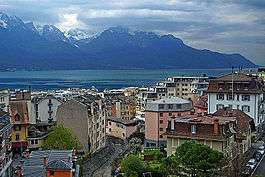Montreux
| Montreux | ||
|---|---|---|
|
Montreux in early-April 2014 | ||
| ||
 Montreux | ||
|
Location of Montreux 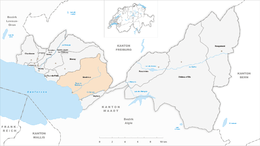 | ||
| Coordinates: 46°26′N 6°55′E / 46.433°N 6.917°ECoordinates: 46°26′N 6°55′E / 46.433°N 6.917°E | ||
| Country | Switzerland | |
| Canton | Vaud | |
| District | Riviera-Pays-d'Enhaut | |
| Government | ||
| • Executive |
Municipalité with 7 members | |
| • Mayor |
Syndic (list) Laurent Wehrli FDP/PRD/PLR (as of February 2014) | |
| • Parliament |
Conseil communal with 100 members | |
| Area[1] | ||
| • Total | 33.37 km2 (12.88 sq mi) | |
| Elevation | 390 m (1,280 ft) | |
| Population (Dec 2015[2]) | ||
| • Total | 26,433 | |
| • Density | 790/km2 (2,100/sq mi) | |
| Postal code | 1820 | |
| SFOS number | 5886 | |
| Localities | Baugy, Brent, Caux, Chailly-sur-Montreux, Chamby, Chaulin, Chêne, Chernex, Clarens, Collonge, Cornaux, Crin, Fontanivent, Glion, Jor, Le Châtelard, Les Avants, Les Planches, Mont-Fleuri, Pallens, Pertit, Planchamp, Sonzier, Tavel, Territet, Vernex, Villard-sur-Chamby, Vuarennes | |
| Surrounded by | Villeneuve, Blonay, Haut-Intyamon, La Tour-de-Peilz, Noville, Veytaux | |
| Twin towns | Wiesbaden (Germany), Menton (France), Chiba City (Japan) | |
| Website |
www Profile (French), SFSO statistics | |
Montreux (French pronunciation: [mɔ̃tʁø]) is a municipality in the district of Riviera-Pays-d'Enhaut in the canton of Vaud in Switzerland.
It is located on Lake Geneva at the foot of the Alps and has a population, as of December 2015, of 26,433[3] and nearly 90,000 in the agglomeration.[4]
History
The earliest settlement was a Late Bronze Age village at Baugy. Montreux lies on the north east shore of Lake Geneva at the fork in the Roman road from Italy over the Simplon Pass, where the roads to the Roman capital of Aventicum and the road into Gaul through Besançon separated. This made it an important settlement in the Roman era. A Roman villa from the 2nd-4th centuries and a 6th–7th century cemetery have been discovered.[5]
In the 12th century, viticulture was introduced to the region, and the sunny slopes of the lake from Lavaux to Montreux became an important wine-growing region. Montreux is first mentioned in 1215 as Mustruel.[5] In 1295, the Bishop of Sion sold the parish of Montreux to Girard of Oron. In 1317, it was split between the Lords of Oron (Le Châtelard) and the Counts of Savoy (Les Planches).[5] A Brotherhood of the Holy Spirit administered estates and a hospital in Montreux starting in about 1309.
The region was subject to various princes, most notably the princes of Savoy from the south side of the lake. They unified the territory which comprises the present canton of Vaud and were generally popular sovereigns.
After the Burgundian Wars in the 15th century, the Swiss in Bern occupied the region without resistance, an indication of the weakness of the princes of Savoy. Under Bernese rule (1536–1798) it belonged to the bailiwick of Chillon (renamed in 1735 into the bailiwick of Vevey).
The Reformation made the region around Montreux and Vevey an attractive haven for Huguenots from Italy, who brought their artisanal skills and set up workshops and businesses.
The abbey of Les Echarpes blanches was founded in 1626.[5]
In 1798, Napoleon liberated the region from the Bernese. In the 19th century, the tourist industry became a major commercial outlet, with the grand hotels of Montreux attracting the rich and cultured from Europe and America.
Starting in the 19th Century there were three independent municipalities that shared a central authority. This county council was made up of four deputies from Le Châtelard, two from Les Planches and one from Veytaux. The church, the market hall of La Rouvenaz, the secondary school (the building was from 1872 and 1897) and the slaughter-house (1912) were all owned by the county council. Each municipality had its own taxes and a mayor. In 1962, the municipalities of Le Châtelard and Les Planches merged, while Veytaux remained independent.[5]
Geography
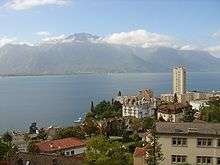
Montreux has an area, as of 2009, of 33.4 square kilometers (12.9 sq mi). Of this area, 8.47 km2 (3.27 sq mi) or 25.4% is used for agricultural purposes, while 16.93 km2 (6.54 sq mi) or 50.7% is forested. Of the rest of the land, 6.37 km2 (2.46 sq mi) or 19.1% is settled (buildings or roads), 0.08 km2 (20 acres) or 0.2% is either rivers or lakes and 1.59 km2 (0.61 sq mi) or 4.8% is unproductive land.[6]
Of the built up area, housing and buildings made up 10.9% and transportation infrastructure made up 6.3%. Out of the forested land, 47.0% of the total land area is heavily forested and 3.1% is covered with orchards or small clusters of trees. Of the agricultural land, 0.4% is used for growing crops and 8.8% is pastures, while 1.6% is used for orchards or vine crops and 14.7% is used for alpine pastures. All the water in the municipality is flowing water.[6]
The municipality was part of the Vevey District until it was dissolved on 31 August 2006, and Montreux became part of the new district of Riviera-Pays-d'Enhaut.[7]
The municipality stretches from Lake Geneva to the foothills of the Swiss Alps (Rochers-de-Naye). It includes the former municipalities of Montreux-Les Planches (until 1952 Les Planches) and Montreux-Le Châtelard (until 1952 Le Châtelard). It was formed in 1962 with the merger of the two former municipalities.
Demographics
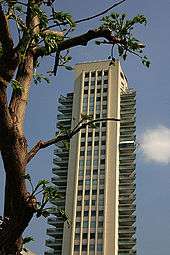
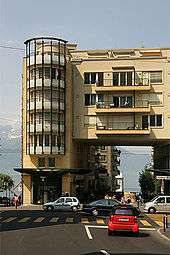
Montreux has a population (as of December 2015) of 26,433.[8] As of 2008, 44.2% of the population are resident foreign nationals.[9] Over the last 10 years (1999–2009 ) the population has changed at a rate of 14.7%. It has changed at a rate of 22.3% due to migration and at a rate of -0.8% due to births and deaths.[10]
Most of the population (as of 2000) speaks French (16,695 or 74.4%) as their first language, with German being second most common (1,398 or 6.2%) and Italian being third (897 or 4.0%). There are 9 people who speak Romansh.[11]
The age distribution, as of 2009, in Montreux is; 2,050 children or 8.3% of the population are between 0 and 9 years old and 3,021 teenagers or 12.2% are between 10 and 19. Of the adult population, 4,216 people or 17.0% of the population are between 20 and 29 years old. 3,016 people or 12.2% are between 30 and 39, 3,552 people or 14.4% are between 40 and 49, and 3,048 people or 12.3% are between 50 and 59. The senior population distribution is 2,565 people or 10.4% of the population are between 60 and 69 years old, 1,795 people or 7.3% are between 70 and 79, there are 1,206 people or 4.9% who are between 80 and 89, and there are 263 people or 1.1% who are 90 and older.[12]
As of 2000, there were 9,380 people who were single and never married in the municipality. There were 9,758 married individuals, 1,631 widows or widowers and 1,685 individuals who are divorced.[11]
As of 2000, there were 9,823 private households in the municipality, and an average of 2 persons per household.[10] There were 4,198 households that consist of only one person and 402 households with five or more people. Out of a total of 10,236 households that answered this question, 41.0% were households made up of just one person and there were 53 adults who lived with their parents. Of the rest of the households, there are 2,563 married couples without children, 2,245 married couples with children There were 605 single parents with a child or children. There were 159 households that were made up of unrelated people and 413 households that were made up of some sort of institution or another collective housing.[11]
In 2000 there were 1,375 single family homes (or 43.2% of the total) out of a total of 3,183 inhabited buildings. There were 1,024 multi-family buildings (32.2%), along with 530 multi-purpose buildings that were mostly used for housing (16.7%) and 254 other use buildings (commercial or industrial) that also had some housing (8.0%).[13]
In 2000, a total of 9,553 apartments (70.7% of the total) were permanently occupied, while 3,043 apartments (22.5%) were seasonally occupied and 916 apartments (6.8%) were empty.[13] As of 2009, the construction rate of new housing units was 1.6 new units per 1000 residents.[10]
As of 2003 the average price to rent an average apartment in Montreux was 1067.93 Swiss francs (CHF) per month (US$850, £480, €680 approx. exchange rate from 2003). The average rate for a one-room apartment was 567.76 CHF (US$450, £260, €360), a two-room apartment was about 787.77 CHF (US$630, £350, €500), a three-room apartment was about 1014.16 CHF (US$810, £460, €650) and a six or more room apartment cost an average of 1817.64 CHF (US$1450, £820, €1160). The average apartment price in Montreux was 95.7% of the national average of 1116 CHF.[14] The vacancy rate for the municipality, in 2010, was 0.55%.[10]
The historical population is given in the following chart:[5][15]

Heritage sites of national significance
The Audiorama, the Swiss National Audiovisual Museum, Crêtes Castle, Châtelard Castle, the Train Station, the Hôtel Montreux Palace, the Caux Palace Hotel, the Ile and Villa Salagnon, the Marché couvert, the Palace-Hôtel, the Territet which was formerly the Grand-Hôtel/the Hôtel des Alpes, served as the recording studio for Deep Purple's record Machine Head, and the Villa Karma are listed as Swiss heritage site of national significance. The entire urban village of Territet / Veytaux as well as the Caux, Montreux and Villas Dubochet areas are all part of the Inventory of Swiss Heritage Sites.[16]
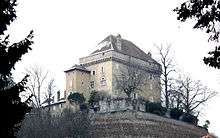 Châtelard Castle
Châtelard Castle Hôtel Montreux Palace
Hôtel Montreux Palace Marché couvert
Marché couvert the Territet which was formerly the Grand-Hôtel/the Hôtel des Alpes
the Territet which was formerly the Grand-Hôtel/the Hôtel des Alpes
Twin Towns
Montreux is twinned with the towns of Menton, France and Wiesbaden, Germany,[17][18] and with the city of Chiba in Japan.[19]
Politics
In the 2007 federal election the most popular party was the SP which received 22.11% of the vote. The next three most popular parties were the SVP (21.97%), the FDP (16.06%) and the Green Party (13.49%). In the federal election, a total of 4,473 votes were cast, and the voter turnout was 39.7%.[20]
Economy
As of 2010, Montreux had an unemployment rate of 6.9%. As of 2008, there were 70 people employed in the primary economic sector and about 27 businesses involved in this sector. 1,165 people were employed in the secondary sector and there were 174 businesses in this sector. 9,290 people were employed in the tertiary sector, with 999 businesses in this sector.[10] There were 10,202 residents of the municipality who were employed in some capacity, of which females made up 46.1% of the workforce.
In 2008 the total number of full-time equivalent jobs was 8,991. The number of jobs in the primary sector was 55, of which 31 were in agriculture, 17 were in forestry or lumber production and 6 were in fishing or fisheries. The number of jobs in the secondary sector was 1,118 of which 403 or (36.0%) were in manufacturing and 708 (63.3%) were in construction. The number of jobs in the tertiary sector was 7,818. In the tertiary sector; 1,296 or 16.6% were in wholesale or retail sales or the repair of motor vehicles, 439 or 5.6% were in the movement and storage of goods, 1,311 or 16.8% were in a hotel or restaurant, 70 or 0.9% were in the information industry, 564 or 7.2% were the insurance or financial industry, 458 or 5.9% were technical professionals or scientists, 943 or 12.1% were in education and 1,591 or 20.4% were in health care.[21]
In 2000, there were 4,949 workers who commuted into the municipality and 4,964 workers who commuted away. The municipality is a net exporter of workers, with about 1.0 workers leaving the municipality for every one entering. About 2.3% of the workforce coming into Montreux are coming from outside Switzerland, while 0.0% of the locals commute out of Switzerland for work.[22] Of the working population, 22.5% used public transportation to get to work, and 50.9% used a private car.[10]
Religion

From the 2000 census, 8,557 or 38.1% were Roman Catholic, while 6,438 or 28.7% belonged to the Swiss Reformed Church. Of the rest of the population, there were 745 members of an Orthodox church (or about 3.32% of the population), there were 18 individuals (or about 0.08% of the population) who belonged to the Christian Catholic Church, and there were 925 individuals (or about 4.12% of the population) who belonged to another Christian church. There were 73 individuals (or about 0.33% of the population) who were Jewish, and 1,031 (or about 4.59% of the population) who were Muslim. There were 80 individuals who were Buddhist, 171 individuals who were Hindu and 90 individuals who belonged to another church. 2,796 (or about 12.45% of the population) belonged to no church, are agnostic or atheist, and 1,941 individuals (or about 8.64% of the population) did not answer the question.[11]
Education
In Montreux about 7,464 (33.2%) of the population have completed non-mandatory upper secondary education, and 3,171 or (14.1%) have completed additional higher education (either university or a Fachhochschule). Of the 3,171 who completed tertiary schooling, 39.8% were Swiss men, 25.3% were Swiss women, 19.8% were non-Swiss men and 15.1% were non-Swiss women.[11]
In the 2009/2010 school year there were a total of 2,106 students in the Montreux school district. In the Vaud cantonal school system, two years of non-obligatory pre-school are provided by the political districts.[23] During the school year, the political district provided pre-school care for a total of 817 children of which 456 children (55.8%) received subsidized pre-school care. The canton's primary school program requires students to attend for four years. There were 1,056 students in the municipal primary school program. The obligatory lower secondary school program lasts for six years and there were 931 students in those schools. There were also 119 students who were home schooled or attended another non-traditional school.[24]
As of 2000, there were 490 students in Montreux who came from another municipality, while 790 residents attended schools outside the municipality.[22]
Public libraries
Montreux is home to the Bibliothèque municipale de Montreux et Veytaux library. The library has (as of 2008) 48,948 books or other media, and loaned out 99,490 items in the same year. It was open a total of 274 days with average of 28 hours per week during that year.[25]
Private schools
The Riviera School or École Riviera, an international school, is in Montreux.[26]
St George's School in Switzerland, a British international school, is in Clarens.
Institut Monte Rosa, an international co-educational boarding school, is in Territet.[27]
Swiss Hotel Management School a private hospitality school, located in Caux.
Hotel Institute Montreux a private hospitality school, located in Montreux.
Glion Institute of Higher Education a private hospitality school, located in Glion
Culture
- It was a haven for Catherine Barkley and Lt. Frederic Henry in Ernest Hemingway's classic, A Farewell to Arms.
Montreux hosts several noteworthy festivals:
- The Septembre musical de Montreux, founded in 1946 and held every year since then.
- Freddie Mercury's Montreux Memorial Day, annually first week-end of September since 2003.[28]
- The Montreux Jazz Festival, annually in July since 1967. It is held at the Montreux Music & Convention Centre, built in 1973 and has become a global phenomenon.
- The Golden Rose Festival, annually in spring (1961–2003), which awarded the Golden Rose of Montreux, an international award for television.
- The Golden Award of Montreux, annually in April, is traditionally, since 1989, the first international advertising and multimedia Competition in Europe - starting the global season for awarding creative excellence.
Montreux boasts one of the most beautiful walks along the lake, stretching from Villeneuve all the way towards Vevey. The main square of the town, Place du Marché, features a statue of Freddie Mercury facing Lake Geneva. Some of the numerous small villages around Montreux include La Tour-de-Peilz, Clarens, Territet, and Villeneuve. The Château of Chillon provides a marvelous view of the entire Lake of Geneva and can be easily accessed via bus, train, walk or boat.
Deep Purple came to Montreux in December 1971 to record Machine Head. The band's famous song "Smoke on the Water" tells of the events of December 1971, when a Frank Zappa fan with a flare gun set the Montreux Casino on fire, destroying the casino where they had originally planned to record the album. Thanks to Claude Nobs who eventually arranged alternate locations, the Grand Hotel was where the album was created and recorded, except for Smoke on the Water which was recorded at La Petit Palais on Rue du Lac. Deep Purple again returned in 1973 to record Burn. The Montreux Casino was reopened in 1975 and later a monument commemorating Deep Purple and their song Smoke on the Water can be found next to the casino.
The Dubliners's song "Montreux Monto" on their album Live at Montreux was recorded live at the Montreux Jazz Festival in 1976.
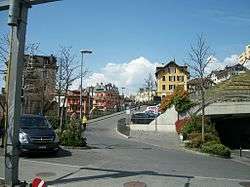
Montreux is the home of Mountain Studios, the recording studio used by several artists. "Bonzo's Montreux" by Led Zeppelin is named after the city where the drums session of John Bonham was recorded in 1976. In 1978, the band Queen bought the studio. It was then sold to Queen producer David Richards. In 2002, the Mountain Studios was converted into a bar as part of a complete renovation of the studio. David Richards has left Montreux to settle down somewhere else. Queen also appeared in 1984 and in 1986 at the Golden Rose Festival and Queen guitarist Brian May appeared in 2001 at the Jazz Festival. Montreux was also the subject of the 1995 Queen single "A Winter's Tale" on the album Made in Heaven, one of Freddie's last songs before his death on November 24, 1991. The album cover features the statue of Mercury beside the lake.
In 1990, the Wakker Prize for the development and preservation of its architectural heritage was awarded to Montreux.[29]
The Fédération Internationale de Roller Sports Federation International de Roller Skating was founded in Montreux in 1924.
Notable residents

- Ian Anderson (born 1947), Scottish musician, frontman of Jethro Tull
- Richard Bonynge, AO, CBE (born 1930), Australian conductor and pianist
- David Bowie (1947–2016), British musician[30]
- Sergei Aleksandrovich Buturlin (1872–1938), Russian ornithologist
- Noël Coward (1899–1973), English playwright, composer, director, actor and singer
- A. J. Cronin (1896–1981), Scottish novelist
- Laurent Dufaux (born 1969), Swiss cyclist
- Jean Villard Gilles (1895–1982), Swiss singer-songwriter
- Patrick Juvet (born 1950), Swiss singer-songwriter
- Oskar Kokoschka (1886–1980), writer and Austrian painter
- Tony Lewis (born 1956), American singer-songwriter
- Zelda Fitzgerald (1900–1948), wife of American author F. Scott Fitzgerald
- Carl Gustaf Emil Mannerheim (1867–1951), Finnish statesman
- Freddie Mercury (1946–1991), British musician, frontman of Queen
- Vladimir Nabokov (1899–1977), Russian-American novelist
- Claude Nobs (1939–2013), Swiss founder of Montreux Jazz Festival
- Luc Plamondon (born 1942), French-Canadian lyricist
- Uri Rosenthal (born 1945), Dutch politician, Minister of Foreign Affairs of the Netherlands (2010-2012)
- Emil Steinberger (born 1933), Swiss comedian, writer, and actor
- Igor Stravinsky (1882–1971), Russian composer
- Dame Joan Sutherland, OM, AC, DBE (1926–2010), Australian opera singer
- Horst Tappe (1938–2005), German photographer
- Pyotr Iliych Tchaikovsky (1840–1893), Russian composer
- Shania Twain (born 1965), Canadian singer-songwriter
- Yechiel Yaakov Weinberg (1884–1966), Lithuanian Rosh Yeshiva of the Hildesheimer Seminary in Berlin and author of the four-volume responsa Sridei Aish
- Empress Elisabeth of Austria (1837–1898), Empress of Austria and Queen of Hungary
- Ardeshir Zahedi (born 1928), former Iranian foreign minister and son-in-law of Shah of Iran
Climate
The Köppen Climate Classification subtype for Montreux's climate is "Cfb" (Marine West Coast Climate/Oceanic climate).[31]
| Climate data for Montreux-Clarens | |||||||||||||
|---|---|---|---|---|---|---|---|---|---|---|---|---|---|
| Month | Jan | Feb | Mar | Apr | May | Jun | Jul | Aug | Sep | Oct | Nov | Dec | Year |
| Average high °C (°F) | 4.5 (40.1) |
6.2 (43.2) |
9.6 (49.3) |
13.9 (57) |
18.2 (64.8) |
21.8 (71.2) |
24.9 (76.8) |
23.9 (75) |
20.5 (68.9) |
15.2 (59.4) |
9.3 (48.7) |
5.5 (41.9) |
14.5 (58.1) |
| Daily mean °C (°F) | 1.5 (34.7) |
2.8 (37) |
5.4 (41.7) |
9.1 (48.4) |
13.3 (55.9) |
16.7 (62.1) |
19.3 (66.7) |
18.6 (65.5) |
15.5 (59.9) |
10.9 (51.6) |
5.8 (42.4) |
2.4 (36.3) |
10.1 (50.2) |
| Average low °C (°F) | −0.8 (30.6) |
0.3 (32.5) |
2.4 (36.3) |
5.5 (41.9) |
9.5 (49.1) |
12.8 (55) |
15.1 (59.2) |
14.7 (58.5) |
12 (54) |
8 (46) |
3.3 (37.9) |
0 (32) |
6.9 (44.4) |
| Average precipitation mm (inches) | 90 (3.54) |
86 (3.39) |
104 (4.09) |
109 (4.29) |
119 (4.69) |
157 (6.18) |
130 (5.12) |
158 (6.22) |
117 (4.61) |
104 (4.09) |
114 (4.49) |
91 (3.58) |
1,379 (54.29) |
| Average precipitation days | 11.6 | 10.6 | 12.4 | 11.9 | 13.8 | 13.1 | 10.3 | 12 | 9.5 | 8.9 | 11 | 11.3 | 136.4 |
| Average relative humidity (%) | 81.8 | 78.4 | 73.7 | 71.6 | 73 | 73.3 | 71.3 | 74.2 | 78.9 | 83.2 | 82.1 | 82.5 | 77 |
| Source #1: MeteoSchweiz[32] | |||||||||||||
| Source #2: Weatherbase[31] | |||||||||||||
Gallery
- Freddie Mercury statue at sunset in Montreux.
 Château de Chillon near Montreux.
Château de Chillon near Montreux. Southwest view over the Lake Geneva from Montreux.
Southwest view over the Lake Geneva from Montreux. Lake Geneva as seen from Montreux, Joseph Mallord William Turner, 1810
Lake Geneva as seen from Montreux, Joseph Mallord William Turner, 1810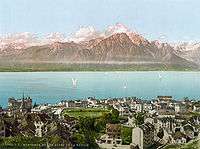 Montreux 1900
Montreux 1900 Another angle of Montreux 1900
Another angle of Montreux 1900
See also
References
- ↑ Arealstatistik Standard - Gemeindedaten nach 4 Hauptbereichen
- ↑ Swiss Federal Statistical Office - STAT-TAB, online database – Ständige und nichtständige Wohnbevölkerung nach institutionellen Gliederungen, Geburtsort und Staatsangehörigkeit (German) accessed 30 August 2016
- ↑ Swiss Federal Statistical Office - STAT-TAB, online database – Ständige und nichtständige Wohnbevölkerung nach institutionellen Gliederungen, Geburtsort und Staatsangehörigkeit (German) accessed 30 August 2016
- ↑ Montreux Riviera website
- 1 2 3 4 5 6 Montreux in German, French and Italian in the online Historical Dictionary of Switzerland.
- 1 2 Swiss Federal Statistical Office-Land Use Statistics 2009 data (German) accessed 25 March 2010
- ↑ Nomenklaturen – Amtliches Gemeindeverzeichnis der Schweiz (German) accessed 4 April 2011
- ↑ Swiss Federal Statistical Office - STAT-TAB, online database – Ständige und nichtständige Wohnbevölkerung nach institutionellen Gliederungen, Geburtsort und Staatsangehörigkeit (German) accessed 30 August 2016
- ↑ Swiss Federal Statistical Office - Superweb database - Gemeinde Statistics 1981-2008 (German) accessed 19 June 2010
- 1 2 3 4 5 6 Swiss Federal Statistical Office accessed 17-August-2011
- 1 2 3 4 5 STAT-TAB Datenwürfel für Thema 40.3 - 2000 (German) accessed 2 February 2011
- ↑ Canton of Vaud Statistical Office (French) accessed 29 April 2011
- 1 2 Swiss Federal Statistical Office STAT-TAB - Datenwürfel für Thema 09.2 - Gebäude und Wohnungen (German) accessed 28 January 2011
- ↑ Swiss Federal Statistical Office-Rental prices 2003 data (German) accessed 26 May 2010
- ↑ Swiss Federal Statistical Office STAT-TAB Bevölkerungsentwicklung nach Region, 1850-2000 (German) accessed 29 January 2011
- ↑ "Kantonsliste A-Objekte". KGS Inventar (in German). Federal Office of Civil Protection. 2009. Retrieved 25 April 2011.
- ↑ Conseil des Communes et Regions d'Europe (French) accessed 27 April 2011
- ↑ "Wiesbaden's international city relations". Retrieved 24 December 2012.
- ↑ "International Exchange". List of Affiliation Partners within Prefectures. Council of Local Authorities for International Relations (CLAIR). Retrieved 21 November 2015.
- ↑ Swiss Federal Statistical Office, Nationalratswahlen 2007: Stärke der Parteien und Wahlbeteiligung, nach Gemeinden/Bezirk/Canton (German) accessed 28 May 2010
- ↑ Swiss Federal Statistical Office STAT-TAB Betriebszählung: Arbeitsstätten nach Gemeinde und NOGA 2008 (Abschnitte), Sektoren 1-3 (German) accessed 28 January 2011
- 1 2 Swiss Federal Statistical Office - Statweb (German) accessed 24 June 2010
- ↑ Organigramme de l'école vaudoise, année scolaire 2009-2010 (French) accessed 2 May 2011
- ↑ Canton of Vaud Statistical Office - Scol. obligatoire/filières de transition (French) accessed 2 May 2011
- ↑ Swiss Federal Statistical Office, list of libraries (German) accessed 14 May 2010
- ↑ "Contact." Riviera School. Retrieved on March 6, 2016. "Avenue des Planches 25, 1820 Montreux"
- ↑ "." Institut Monte Rosa. Retrieved on June 1st, 2016. "Avenue de Chillon 57, 1820 Montreux"
- ↑ "Freddie Mercury: the show must go on!" (in French). Swissinfo. 2003-08-31. Retrieved 2008-08-19.
Et voilà qu’en cette année 2003, c’est carrément un 'Memorial Day' qui est organisé en l’honneur de Faroukh Bulsara, né en 1946 à Zanzibar, et devenu star planétaire sous le nom de Freddie Mercury.
- ↑ Swiss Heritage Society, Wakker Prize (German) accessed 9 May 2009
- ↑ http://www.swissinfo.ch/eng/turn-and-face-the-strange_david-bowie--the-swiss-years/41886858
- 1 2 Climate Summary for Montreux accessed 27 June 2013
- ↑ "Temperature and Precipitation Average Values-Table, 1961-1990" (in German, French, and Italian). Federal Office of Meteorology and Climatology MeteoSwiss. Retrieved 8 May 2009.
External links
| Wikimedia Commons has media related to Montreux. |
| Wikivoyage has a travel guide for Montreux. |
- Montreux-Vevey Tourisme official website of Montreux Riviera Tourist Office
- fusions.ch: culture and tourism in Montreux with many photo galleries of the region
- Montreuxmusic.com
- www.montreux.ch portal
- Commune de Montreux official website (French)
- Montreux in German, French and Italian in the online Historical Dictionary of Switzerland.
- Planches, Les in German, French and Italian in the online Historical Dictionary of Switzerland.
- Châtelard, Le (VD) in German, French and Italian in the online Historical Dictionary of Switzerland.
 Montreux travel guide from Wikivoyage
Montreux travel guide from Wikivoyage- Official site of the Montreux Jazz Festival
- Freddie Mercury and Queen items for sale in Montreux
- Webcam (this is broken at the moment)
- Montreux Christmas Market
- Deep Purple's Ian Gillan write-up on the Flare Gun incident and subsequent song
- "Mr. Nabokov is not in his room" - Doron Rosenblum's pilgrimage to Montreux, Ha'aretz, Sept. 18., 2009
- Current weather and forecasts for Montreux
- Promove Official site of the Economical Promotion of Montreux-Vevey
